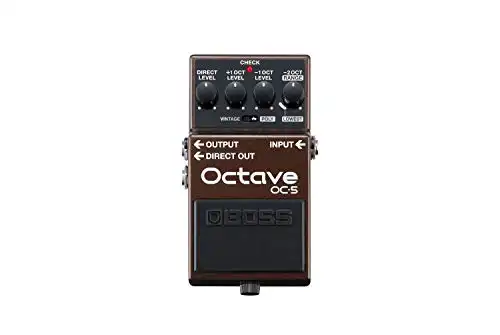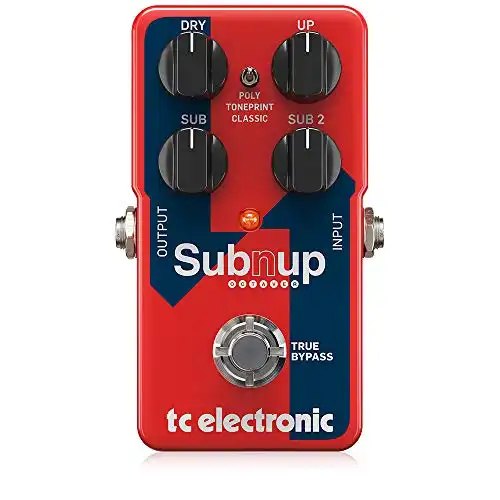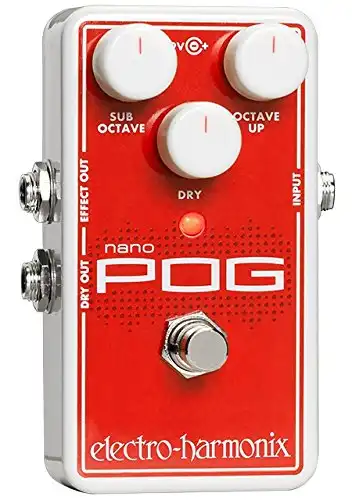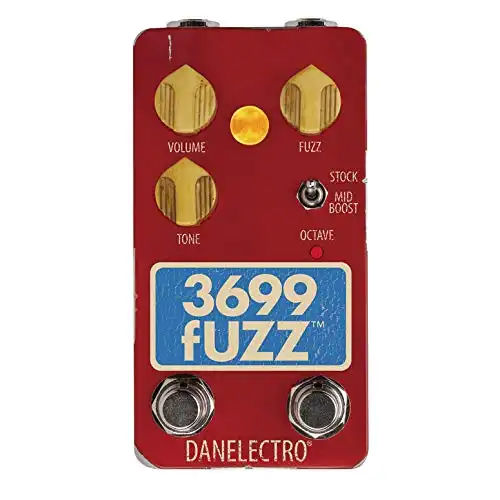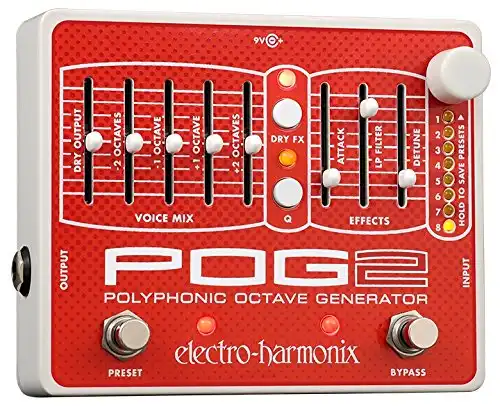Are you in search of the best octave pedal for guitar?
There’s a seemingly endless number of octave pedals on the market that all do slightly different things. For each type of octave pedal out there, you can choose from dozens of pedals. Every single octave pedal morphs your tone into something unique and captivating. It’s important to consider what makes each pedal different and to identify your individual tone-shaping needs.
If you’re not familiar with octave pedals, they can transform your guitar into a symphony orchestra, sometimes seeming to defy physics and make it sounds like multiple guitarists playing at once. They take every note you play and multiply it, pitching it up or down one or more perfect octaves. They provide deep bass tones or piercing highs. For more information about octave pedals see our What Does an Octave Pedal Do? article.
Features to look out for
Monophonic
Monophonic octave pedals are only capable of processing one note at a time. Therefore, these monophonic pedals do poorly when trying to process chords, and the result may be a garbled mess. Then again, some of us are into that sort of thing!
Monophonic pedals thrive within their limitations. As different notes compete for the pedal’s attention, they produce a glitchy tone that is difficult to replicate. Classic octave pedals, like the Roger Mayer Octavia, are all monophonic. Many purists stand by the thick, warm tone produced by monophonic pedals, made famous by Jimi Hendrix in songs like “Purple Haze” and “Fire.”
Polyphonic
Polyphonic octave pedals are the modern successors to their one-note-at-a-time forbearers. These pedals can process several notes simultaneously, opening up the doors to what is possible for guitarists.
Analog vs. digital
The war between digital and analog pervades discussion of nearly every type of music gear, and here is no exception. However, the choice becomes a bit more complex when it comes to octave pedals.
As with most music gear, the classic analog circuits produce a warm, natural-sounding tone that their digital counterparts often struggle to replicate. However, their technology restricts analog octave pedals and lack many features modern guitarists want. Most importantly, they are strictly monophonic.
Digital octave pedals have come a long way in recent years. They are almost all polyphonic, and many of them can toggle to a monophonic mode that may fool even the most loyal purists. They often provide a wide variety of additional controls for shaping your tone, including frequency cutoffs and a wide range of octaves.
Fuzz
Early analog octave pedals usually feature a gain knob that produces natural, fuzzy distortion when cranked. As this became a more sought-after feature, pedal manufacturers began to blur the line between fuzz and octave pedals. Many modern octave pedals are capable of producing earth-shaking, heavy fuzz that dwarfs earlier pedals.
Our picks for best octave pedals
There’s an ocean of octave pedals out there with an array of different features. With such a wide range to choose from, there’s a pedal out there for every need and budget.
Best Overall Octave Pedal – Boss OC-5
- Vintage mode faithfully reproduces the mono sound of the original OC-2
- Poly mode for chord playing
- Lowest Range setting in Poly mode applies the octave effect to only the lowest note in a chord
The Boss OC-5 is an incredibly versatile pedal that produces powerful octave sounds and provides precise control.
Boss has continually pushed the boundaries of what octave pedals can do. The OC-2 is still one of the most sought-after analog octave pedals. The OC-3 completely redefined the genre as the world’s first polyphonic octave pedal.
The Boss OC-5 combines the old world with the new. Its “vintage mode” replicates the classic sounds of the OC-2, offering two octaves down of deep sub-bass.
Polyphonic mode offers both octaves up and down that can be triggered simultaneously. The OC-5’s “range control” knob acts as a cutoff filter in the polyphonic mode that provides extreme flexibility. Turned to the left, the OC-5 will only create octaves based on the lowest note played in a chord. To the right, and the OC-5 will effortlessly track every note with precision.
The Boss OC-5 is also an ideal choice for acoustic guitarists and singer/songwriters. The pedal’s chord mode fills the sonic space of a bass player. Meanwhile, the dual output allows the sound engineer to mix the octaves and the guitar’s natural sound separately.
Pros
- Excellent digital tracking of notes for precision
- Range control offers important versatility
- Vintage monophonic and modern polyphonic modes
- Dual outputs
Cons
- Octave up sounds are brittle and slightly distorted
Best Value Octave Pedal – TC Electronics Sub’ n’ Up
- Blend controls for dry, octave-up and two sub-octaves
- Polyphonic tracking mode
- Classic monophonic octaver mode
- TonePrint Editor with Modulation
The TC Electronic Sub’ n’ Up is a perfect pedal for beginners or pros and offers huge sounds at an affordable price.
The Sub’ n’ Up shines as a versatile polyphonic pedal, offering 2 octaves down and 1 octave up that can be processed simultaneously and mixed independently. With a simple flick of a switch, the Sub’ n’ Up turns into a vintage monophonic beast, offering perfectly glitchy tones perfect for dirty rock leads.
The Sub’ n’ Up’s versatility opens way up with the implementation of TC Electronics’ Toneprint technology. Players can finetune the pedal’s tone and add additional modulation effects via the Toneprint mobile app. User-created presets can be beamed to the pedal wirelessly for worlds of possibilities.
Pros
- Powerful, professional-sounding octaves at an affordable price
- Polyphonic and Monophonic modes
- Toneprint offers extreme versatility
- Three octave tones that can be mixed independently
Cons
- Single output
- Limited features on the pedal itself
Best Analog Octave Pedal – EarthQuaker Devices Tentacle V2
- Classic analog octave up effect
- Simple controls
- Relay based switching allows for traditional latching or momentary operation
The EarthQuaker Devices Tentacle V2 is a simple octave up pedal that beautifully recreates classic tones. EarthQuaker Devices’ popular fuzz pedal, Hoofreaper, featured an “octave up” button so popular that fans demanded they create a standalone pedal with that feature. They listened and released the Tentacle.
The Tentacle V2 is as simple and classic as an octave pedal could get. There are no knobs to tweak and no switches to flick. One footswitch button engages the pedal, creating a monophonic octave up reminiscent of the classic Octavia. Unlike most other pedals that react with the guitar’s volume control, the Tentacle V2 responds very well with the tone knob and provides easy control over the pedal’s effects.
Pros
- Classic, simple design
- Beautifully rich harmonics
- Excellent build quality
Cons
- Minimal feature set
- No octave down
Best Polyphonic Octave Pedal – Electro-Harmonix Nano POG
- 3 knobs control your mix of dry sound, sub octave and octave up
- Incredibly fast-tracking
- EHX9.6DC power supply included
The Electro-Harmonix Nano POG produces crystal clear polyphonic octaves for a rich and full-bodied sound.
The Nano POG precisely creates multiple octaves from single notes or chords. Incredibly fast-tracking ensures that notes are crystal clear with no glitchy harmonics. This octave pedal is so clear that it can mimic the sound of a 12-string guitar or an organ.
The Nano POG features separate controls for an octave down and an octave up. The “dry” control lets you carefully mix the octaves in with your guitar’s dry tone.
The Nano POG also features two outputs: “effect out” and “dry out.” These multiple outputs allow a sound engineer to mix the effect into a venue’s PA system.
Pros
- Fast, accurate tracking of single notes or chords
- Easy to access a wide variety of sounds
- Dual outputs
- Sturdy build quality
Cons
- No monophonic mode
- Relatively expensive
Best Octave Fuzz – Danelectro 3699
- Classic 70s rock fuzz
- Separate footswitch for octave
In the early 1970s, current Danelectro owner Steve Ridinger created the FOXX pedal company in southern California. One of their most popular products, the FOXX ToneMachine, is a dual octave-up and fuzz pedal that sells for about $600 on the used market today.
The Danelectro 3699 brings the ToneMachine into the modern-day. The pedal, whose numerical name spells FOXX on a telephone, is built with the same circuit design as its ancestor. Several modern tweaks improve that design to make the 3699 capable of even more incredible tones than the original.
While the original ToneMachine only had one footswitch, the 3699 features separate switches to activate the pedal itself and to activate the monophonic octave circuit. These switches allow guitarists to create a warm blanket of fuzz throughout a song, then kick on the octave to boost a solo.
The 3699 features volume, fuzz, and tone knobs for precise sound design. The volume and fuzz can be tweaked to shape sound from a slightly gritty overdrive to a bone-shaking distortion. The pedal’s versatility shines with the tone knob, which shapes warm, wooly fuzz when turned to the left, and sharp, piercing distortion when turned to the right.
One of the most welcome new additions is the toggle switch between “mid boost” and “stock.” One complaint some guitarists have with the original ToneMachine is a deep cut to the mid frequencies. This toggle allows guitarists to choose between the classic FOXX sound or a more full-bodied fuzz.
Pros
- Classic 70s rock fuzz
- Separate footswitch for octave
- Great control for sculpting tone
- Mid boost improves upon a classic design
Cons
- No option to power with battery
- No polyphonic option
- No sub octave
Best Premium Octave Pedal – Electro-Harmonix POG2
- Fast-tracking
- 8 storable presets
- Independently mix 3 separate octaves
The POG2 offers more versatility than any octave pedal on the market. It features 1 sub-octave, 2 octaves up, and a set of envelope filters. It can transform your tone, sounding like a jangly 18-string guitar, a warm organ, and a lush string orchestra.
POG stands for “polyphonic octave generator,” and it doesn’t pretend to be anything else. You won’t find any monophonic mode here for glitchy classic rock harmonics. Instead, you’ll get up to four octaves that perfectly track every note played, whether it’s one single note, an arpeggio, or a full chord.
The POG2 pushes the boundaries of what could be considered an octave pedal and turns your guitar into something more like a synthesizer. Engaging just 1 octave up or down creates sounds reminiscent of other octave pedals. Enabling all 3 makes shimmering organ sounds that are difficult to believe are coming from a guitar.
The pedal’s right side features sound-sculpting tools similar to those found on a synthesizer’s envelope controls. All of these effects can be either triggered or bypassed with the FX button.
The first slider controls the note’s attack. When adjusted just a little bit, this slider hides the picking sounds of the string. Changing it all the way creates huge volume swells that mimic a string orchestra.
The low pass filter shapes the brightness of the octaves. On one extreme, the sound becomes almost muffled. On the other, the pedal expresses the entire tone of the octaves that is open, expressive, and bright.
The detune option adjusts the pitch to create imperfect octaves. These detuned octaves generate a sort of swirling and swelling effect reminiscent of a mellotron.
The POG2 offers endless opportunities for creating new sounds. It conveniently offers 8 preset slots for quickly recalling your favorite sounds, allowing great flexibility when using in the studio or live.
Pros
- Incredibly fast-tracking for precise octaves
- Ability to independently mix 3 separate octaves
- The envelope shaping FX section transforms the guitar
- 8 storable presets
Cons
- Only 1 output
- Expensive
Conclusion
The definition of an octave pedal has completely evolved over the years. The Octavias of the past are almost a different species than the POGs of today. Yet, there’s a place for each within today’s music world. With technology, we can often have both in one compact package. Regardless of what your needs are, there’s an octave pedal that’s perfect for you.
